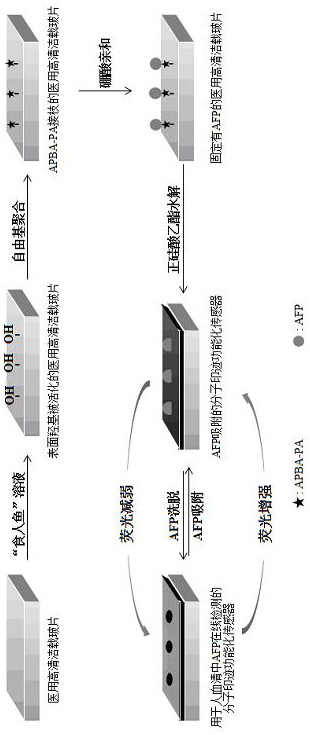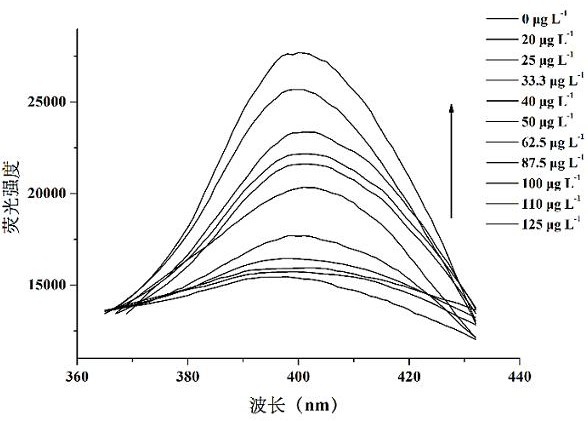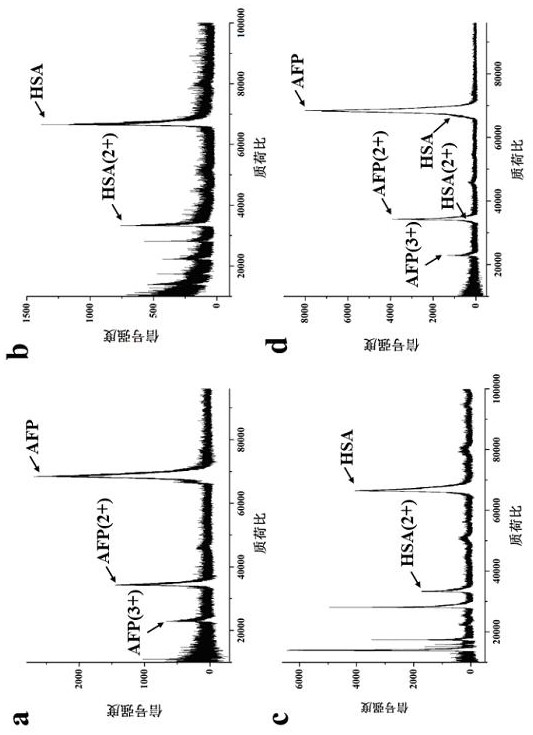Preparation of a Molecularly Imprinted Sensor for Online Detection of AFP in Human Serum
A molecular imprinting and sensor technology, applied in the field of biomedicine, can solve the problems of fluorescence change and research that have not been reported yet, and achieve the effects of easy modification, good portability and high sensitivity
- Summary
- Abstract
- Description
- Claims
- Application Information
AI Technical Summary
Problems solved by technology
Method used
Image
Examples
Embodiment 1
[0040] Example 1 Preparation of a molecularly imprinted sensor for online detection of AFP in human serum (such as figure 1 shown), including the following steps:
[0041] ⑴ Preparation of (3-2-(4-(acryloyloxy)methyl)-1H-1,2,4-triazol-1-yl)acetamido)phenyl)boronic acid, namely APBA-PA (ACS Appl . Mater. Interfaces., 2014, 6, 1406-1414):
[0042] Weigh 1.488g of 3-aminophenylboronic acid hemisulfate and 2.016g of sodium bicarbonate and dissolve in 80 mL of ultrapure water, then add 3.680g of bromoacetyl bromide dropwise. The reaction solution was reacted in an ice-water bath for 2 h, and then continued to react for 16 h at room temperature. After the reaction, the precipitate was filtered out and redissolved in 20 mL sodium hydroxide solution (0.5 M). The pH of the solution was adjusted to 2.0, and the precipitate was filtered off and lyophilized.
[0043] Weigh 1.37g of the above product and 0.36g of sodium azide and dissolve it in 21 mL of N,N-dimethylformamide. After st...
Embodiment 2
[0062] Example 2 The preparation of a molecular imprinted sensor for online detection of AFP in human serum comprises the following steps:
[0063] ⑴ ~ ⑼ with embodiment 1.
[0064] (10) The cleaned carrier was first immersed in piranha solution, and the surface hydroxyl group activation reaction was carried out at 110 °C for 0.5 h, and then immersed in MPS absolute ethanol solution with a volume concentration of 10% at 75 °C for 20 min, and finally After rinsing with absolute ethanol and drying naturally, the double-bond functionalized carrier was obtained.
[0065] (11) The double-bond functionalized carrier was immersed in APBA-PA absolute ethanol solution with a mass concentration of 40%, and then AIBN equivalent to APBA-PA was added, and free radical polymerization was carried out at 72°C. After 6 h, the reaction was completed. Rinse with absolute ethanol and blow dry with nitrogen to obtain the APBA-PA grafted carrier.
[0066] ⑿ Immerse the APBA-PA grafted carrier int...
Embodiment 3
[0068] Example 3 The preparation of a molecular imprinted sensor for online detection of AFP in human serum comprises the following steps:
[0069] ⑴ ~ ⑼ with embodiment 1.
[0070] (10) The cleaned carrier was first immersed in piranha solution, and the surface hydroxyl group activation reaction was carried out at 90 °C for 2 h, and then immersed in MPS absolute ethanol solution with a volume concentration of 5% at 65 °C for 40 min, and finally After rinsing with absolute ethanol and drying with nitrogen gas, the double bond functionalized carrier was obtained.
[0071] (11) The double-bond functionalized carrier was immersed in APBA-PA absolute ethanol solution with a mass concentration of 20%, and then AIBN equivalent to APBA-PA was added, and free radical polymerization was carried out at 69 °C. After 15 h, the reaction was completed. Rinse with absolute ethanol and blow dry with nitrogen to obtain the APBA-PA grafted carrier.
[0072] ⑿ Immerse the APBA-PA grafted carri...
PUM
 Login to View More
Login to View More Abstract
Description
Claims
Application Information
 Login to View More
Login to View More - R&D
- Intellectual Property
- Life Sciences
- Materials
- Tech Scout
- Unparalleled Data Quality
- Higher Quality Content
- 60% Fewer Hallucinations
Browse by: Latest US Patents, China's latest patents, Technical Efficacy Thesaurus, Application Domain, Technology Topic, Popular Technical Reports.
© 2025 PatSnap. All rights reserved.Legal|Privacy policy|Modern Slavery Act Transparency Statement|Sitemap|About US| Contact US: help@patsnap.com



